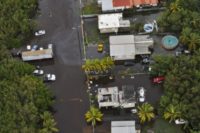Flood Insurance
A Step Toward Disaster-Recovery Sanity
Congress can open the door to private flood insurance
The U.S. House of Representatives edged U.S. flood insurance policy—and with it, risk financing needed to rebuild after losses from flooding—closer to rationality with a unanimous vote April 28. It approved H.R. 2901, which opened the path to more participation of private insurers. Right now, flood insurance is available primarily via a subsidized federal flood insurance program and is generally excluded as a risk in privately purchased property coverage.
The federal National Flood Insurance Program (NFIP) has accumulated a roughly $24-billion debt, says Anthony Kammas, a partner in insurance broker Skyline Risk Management in New York City, because the U.S. government set premiums below actual risks and failed to collect enough to cover claims.
The NFIP legislation in 1968 allowed policies to be written prior to flood insurance rate maps, primarily for property owners in high-risk areas, says Insurance Journal, and now about one out of five NFIP policies has subsidized rates. In essence, U.S. taxpayers finance the risk of property owners in flood-prone areas.
Private insurers aren’t asking to take over yet. The National Association of Professional Insurance Agents, for example, doesn’t support immediate shifting all flood insurance to the private sector. Kammas, who is active in the association’s New York chapter, says that with real underwriting of flood insurance rates and the continuation of federally subsidized rates, the federal government should gradually become the flood insurer of last resort rather than the only choice.
Meanwhile, the private flood insurance industry is awaiting new, more realistic flood maps to be completed—as well as a multiyear reauthorization of NFIP.
Although private-sector insurers aren’t always regarded with the same warm respect that is enjoyed by other sectors of the business world, they inject a necessary discipline. That discipline will be needed in an age of violent, unpredictable weather. Significantly, disaster insurance reform has united a coalition of anti-tax advocates, insurers and environmentalists.
Some collaboration is already taking place. Policy website SmarterSafer.org (formerly Americans for a Smart Natural Catastrophe Policy), for example, counts among its members the Natural Resources Defense Council, Taxpayers for Common Sense, and insurers Chubb Corp. and Allianz. Its encouragement of policies that don’t incentivize living in hurricane- and flood-prone areas and of NFIP reform that includes accurate maps, risk-based rates and a focus on mitigation seems to represent one sensible approach.
Meanwhile, the broad coalition of industries and associations that supported the bill passed by the House will be needed to push the Senate to adopt its version. There are good reasons for supporting it.




